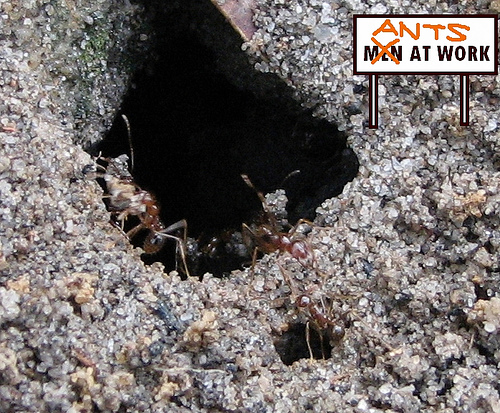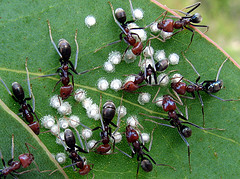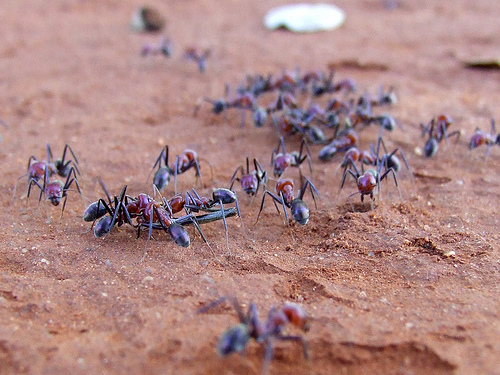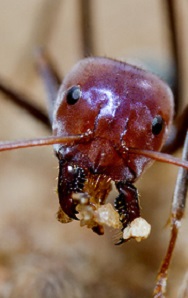Reproduction
Each ant colony starts out with a reproductive queen, whose sole purpose is to reproduce. The queen may mate with one or multiple males during her brief mating period, but never mates again. Colony development starts with massive “nuptial flights” where virgin queens meet with winged males (Science Encyclopedia). After fertilization the queen stores the sperm from the male in order to fertilized new eggs in the future to maintain the colony population. Once a colony is substantiated, they develop into a univoltine cycle, or producing a new generation each year (Taylor 2007). The new fertilized eggs soon develop into larvae where they are cared for by freshly hatch workers. During the larvae stage the queen will commonly secrete a chemical that retards wing growth and ovary development in females, which solidifies their roles as workers, rather than fertile individuals (Science Encyclopedia). For proper development, larvae and pupae need to be kept at a relatively consistent temperature, and so are moved around the colony’s chambers (Hölldobler and Wilson 1990).
Contrary to popular belief, some ant nest have multiple
queens or none at all, multiple queen colonies are referred to as
“queen-right” colonies and nests without a queen are called “gamer
gate” colonies (Peeters and Hölldobler 1995). Unfertilized
eggs develop into winged males who do not work; their only job is to
fertilize a virgin queen when necessary. The fertilized eggs
develop into infertile, female workers who perform the everyday
tasks of the nest. Freshly hatched Iridomyrmex purpureus workers spend
their first days caring for the young and queen. Later, she
will graduate into a role of nest “maintenance” and eventually a
colony defender and forager. This “caste” system is believed
to take place because of the high risk involving foraging and
defending the nest. These jobs are left to the older, mature
ants who are most likely to die soon of natural causes (Traniello
1989).
a queen are called “gamer
gate” colonies (Peeters and Hölldobler 1995). Unfertilized
eggs develop into winged males who do not work; their only job is to
fertilize a virgin queen when necessary. The fertilized eggs
develop into infertile, female workers who perform the everyday
tasks of the nest. Freshly hatched Iridomyrmex purpureus workers spend
their first days caring for the young and queen. Later, she
will graduate into a role of nest “maintenance” and eventually a
colony defender and forager. This “caste” system is believed
to take place because of the high risk involving foraging and
defending the nest. These jobs are left to the older, mature
ants who are most likely to die soon of natural causes (Traniello
1989).
Ant colonies, including the I. purpureus, are usually long-lived if undisturbed by outside forces, some queens are believed to live for up to 30 years with workers ranging from 1-3 years. However, this is not the case for the common male ant, which is short-lived, existing for only a few weeks (Keller 1998). Another reason the I. purpureus can be so successful directly correlates with its environmental climate. Ant species in the northern, cooler climates, exhibit a dormant stage, where no activity is happening. Australia, providing reasonably constant temperature, allows the species to be active 365 days a year, without the fear of freezing temperatures.
Continue to the Interactions page


